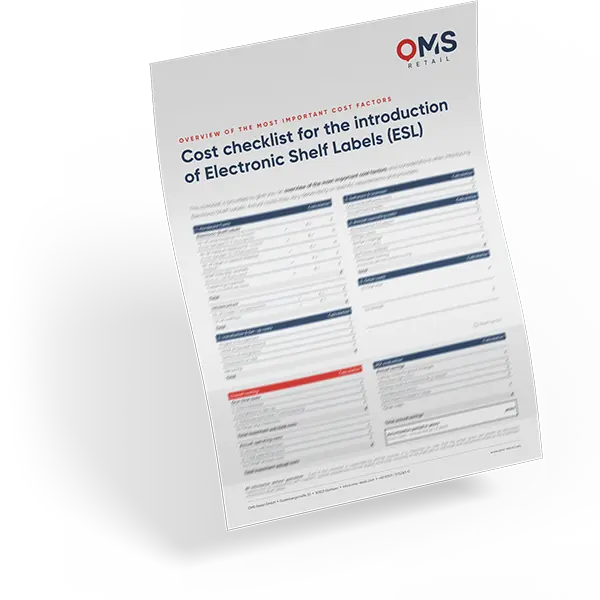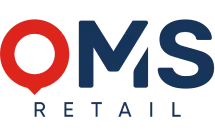Digital price tags: When the investment is worthwhile and how high the costs are!
Digital price labelling is revolutionizing brick-and-mortar retail. For independent retailers, store managers, and purchasing managers, it's crucial to recognize the right time to make the switch and understand the associated costs. In this article, we explore the benefits of digital price tags, the cost factors involved, and how you can ensure your investment is worthwhile by maximizing long-term profitability.

When is it worth switching to digital price tags?
6 important factors - Practical decision-making aid - Concrete examples from the retail sector

How high are the costs for the introduction of digital price tags?
The investment costs for electronic shelf label systems are made up of hardware, software, implementation and maintenance/support and vary depending on the size of the company, the number of labels required and specific requirements. Below you will find an overview of the typical cost structures that we have compiled for you from official sources.
Hardware costs per digital price tag
E-Ink displays (energy-saving, only with changes in power consumption):
1.5-3.5 inches: €6 - €14 per unit
LCD displays (color, for dynamic advertising): from 50 € per piece
=====================================================
Example calculation for 100 digital price tags (E-Ink - 3.5 inch):
100 × 14 € = 1,400 €
=====================================================
Infrastructure and installation costs
Gateway/router: For wireless communication (approx. €300-1,000).
Installation of digital price tags: 1-3 € per piece (depending on the mounting).
=========================================
Example costs for 100 ESL price tags:
Gateway (500 €) + installation (100 × 3 €) = 800 €
=========================================
Software and one-off costs
Cloud software license: From €50/month for basic versions.
One-off implementation: training, system customization and data integration (€1,000-5,000).
Additional cost items: Ongoing costs for maintenance and updates or similar issues may also be incurred, which we were unfortunately unable to take into account.
============================================================
Sample calculation:
Software (€60/month × 12) + implementation (€2,000) = €2,720/year
============================================================
Sample calculation: Implementation costs for digital price management
1. Hardware costs
- ESL price tags: 2,500 × 14 € = 35,000 € (E-Ink 3.5 inch displays)
- Additional hardware (access points, server, infrastructure): ≈ 3.000 €
- Total hardware: €38,000
2. Software & licenses
- Basic software for price management: € 10,000 (one-off)
- Annual maintenance/updates: € 2,000
3. Installation & training
- Assembly and system setup: € 5,000
===================================
Total investment purchase (year 1):
€ 38,000 + € 12,000 + € 5,000 = € 55,000
===================================
Sample calculation: Annual savings potential
1. personnel cost savings
- Time saving:
- Per ESL sign: 0.16 hours/month for manual price updating
- With 300 promotional items that undergo a price change twice a week, the following values result:
- Price changes per week: 300 items × 2 changes = 600 changes
- Price changes per month: 600 changes/week × 4 weeks = 2,400 changes
- 2,400 × 0.16 h = 384h/month - Cost saving (at 15 €/h): 384 h × €15 × 12 months = €69,120/year
2. material cost savings
- Paper, printer cartridges, disposal
- Per sign: 5 €/year
- Total: 2,500 × 5 € = 12,500 €/year
========================
Total savings per year:
€69,120 + €12,500 = €81,620
========================
Sample calculation: Amortization time of digital price tags and conclusion
Critical classification
1. optimistic assumptions:
- The time saving of 0.16 h/sign is based on industry benchmarks, but may vary depending on process efficiency.
- Dynamic price adjustments (e.g. seasonal discounts) could increase savings.
2. additional costs:
- Maintenance: €2,000/year (software updates, hardware repairs).
3. extended benefits:
- Increase in sales: through quick price changes during peak demand (e.g. Black Friday).
- Error reduction: Avoidance of manual pricing errors (estimated savings: 1-2% of sales).
Conclusion
The investment of €55,000 represents a significant investment, but one that can be amortized relatively quickly. Even in the worst-case scenario, the investment of 2,500 digital price tags would pay for itself after around one year. Larger projects benefit from economies of scale, which makes digital price labeling particularly attractive for supermarkets, drugstores and electronics chains.
Even if this calculation is supported by official sources, it is important to note that this calculation is based on estimates and projections. Actual costs and savings may vary depending on the specific circumstances of the business. Factors such as negotiations with suppliers, specific price tag requirements or individual workflows can influence the final figures.
Correctly classify sample calculation
All information without guarantee - Although the example calculation is supported by official sources, it is important to note that this calculation is based on estimates and projections. Actual costs and savings may vary depending on the specific circumstances of the company. Factors such as negotiations with suppliers, special requirements for the digital price tags, disposal of old shelf rails or individual work processes can influence the final figures.
Is it worth investing in a digital award?
Switching to digital price tags is particularly beneficial for retailers with extensive product ranges, frequent price changes, large store networks or a strong focus on sustainability. Implementing ESL systems can increase operational efficiency, improve the customer experience and increase competitiveness. Companies should evaluate their specific requirements and objectives to maximize the benefits of digital price tags.
